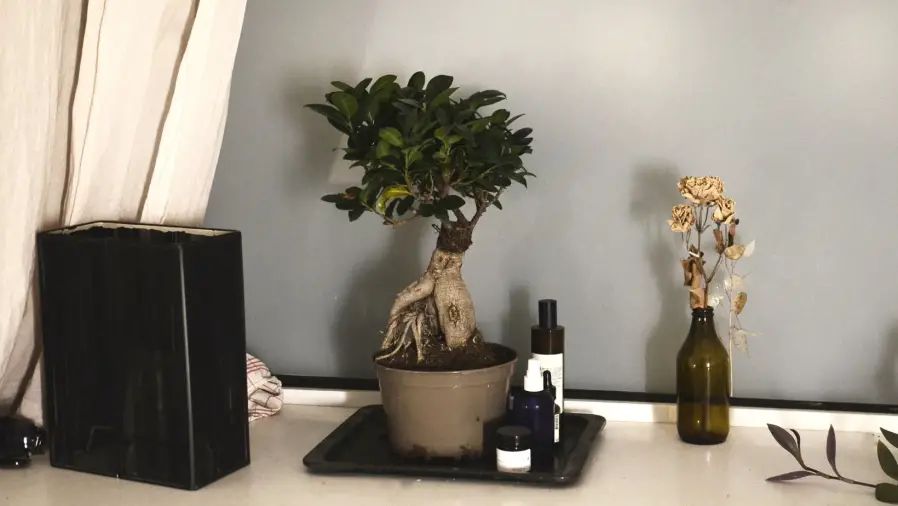Introduction
In the realm of home décor, there’s a natural treasure that’s been captivating enthusiasts for centuries: the Ficus Bonsai. With its enchanting presence, the Ficus Bonsai brings a touch of green elegance into your living space, infusing it with tranquility and beauty. Whether you’re a seasoned plant aficionado or just beginning your journey into the world of bonsai, this article is your comprehensive guide to everything you need to know about the Ficus Bonsai: The Green Elegance You Need in Your Home Right Now.

Ficus Bonsai: The Green Elegance You Need in Your Home Right Now
The Ficus Bonsai, a miniature tree artfully cultivated to mimic the majestic forms of full-sized trees, is a captivating addition to any living space. Its intricate branches, delicate leaves, and intricate root systems showcase nature’s beauty in miniature form. This ornamental plant is more than just a piece of decoration; it’s a living work of art that brings nature indoors.
Table of Contents
- Introduction
- Ficus Bonsai: The Green Elegance You Need in Your Home Right Now
- Types of Ficus Bonsai
- Benefits of Having a Ficus Bonsai
- Caring for Your Ficus Bonsai
- FAQs about Ficus Bonsai
- Conclusion
Types of Ficus Bonsai
There are several types of Ficus Bonsai that offer distinct characteristics and appearances. Some popular varieties include:
1. Ficus Retusa Bonsai
The Ficus Retusa, also known as the “Banyan Fig,” features small, dark green leaves and a robust, twisting trunk. This variety is well-suited for beginners due to its resilience and adaptability.
2. Ficus Ginseng Bonsai
Recognized by its thick, bulbous roots and glossy leaves, the Ficus Ginseng exudes an air of vitality. Its unique appearance makes it a favorite among bonsai enthusiasts seeking an unconventional yet striking addition to their homes.
3. Ficus Microcarpa Bonsai
Commonly referred to as the “Chinese Banyan,” this Ficus Bonsai boasts tiny, elliptical leaves and an intricate network of aerial roots. Its intricate appearance adds a touch of sophistication to any environment.
Benefits of Having a Ficus Bonsai
Embracing the art of Ficus Bonsai cultivation offers numerous advantages beyond aesthetic appeal:
- Stress Relief: The act of tending to your Ficus Bonsai can be a soothing and therapeutic experience, promoting relaxation and reducing stress.
- Indoor Air Quality: Ficus Bonsai trees act as natural air purifiers, improving indoor air quality by removing pollutants and toxins.
- Enhanced Focus: Caring for a bonsai tree requires attention and patience, fostering improved concentration and mindfulness.
Caring for Your Ficus Bonsai
Nurturing a Ficus Bonsai is a rewarding journey that requires some know-how. Here’s a step-by-step guide to caring for your bonsai:
- Placement: Position your bonsai in a location with bright, indirect sunlight. Avoid harsh, direct sunlight that can scorch the leaves.
- Watering: Keep the soil consistently moist, but not waterlogged. Water when the topsoil feels slightly dry to the touch.
- Pruning: Regularly prune your Ficus Bonsai to maintain its shape and encourage new growth. Remove any dead or yellowing leaves to promote overall health.
- Fertilizing: Feed your bonsai with a balanced liquid fertilizer during the growing season (spring and summer) every 4-6 weeks.
- Repotting: Repot your Ficus Bonsai every 2-3 years to ensure proper root development. Use a bonsai-specific soil mix for optimal growth.

FAQs about Ficus Bonsai
Q: How often should I water my Ficus Bonsai?
A: Water your Ficus Bonsai when the topsoil feels slightly dry to the touch. The frequency may vary depending on factors like humidity and temperature.
Q: Can I keep my Ficus Bonsai outdoors?
A: While Ficus Bonsai can thrive outdoors, they should be protected from extreme weather conditions and direct sunlight, which can damage their delicate leaves.
Q: What should I do if my bonsai’s leaves turn yellow?
A: Yellowing leaves can indicate overwatering or poor drainage. Adjust your watering routine and ensure proper drainage to prevent root rot.
Q: How do I prune my Ficus Bonsai?
A: Use sharp bonsai pruning shears to trim back new growth, maintaining the desired shape. Remove any dead or yellowing leaves and branches to encourage healthy growth.
Q: Can I shape my Ficus Bonsai in different styles?
A: Absolutely! Ficus Bonsai can be shaped into various styles, including formal upright, cascade, and slanting, allowing you to express your creativity.
Q: Is repotting really necessary?
A: Yes, repotting is essential for Ficus Bonsai. It promotes healthy root growth and prevents the tree from becoming root-bound in its pot.
Conclusion
Incorporating a Ficus Bonsai into your home is like inviting a piece of nature’s elegance to grace your living space. With its captivating forms, therapeutic benefits, and endless possibilities for cultivation, the Ficus Bonsai truly is the green elegance your home needs right now.
So, if you’re ready to infuse your space with the beauty of Ficus Bonsai: The Green Elegance You Need in Your Home Right Now, take the plunge and embark on a journey of nurturing and creativity.
